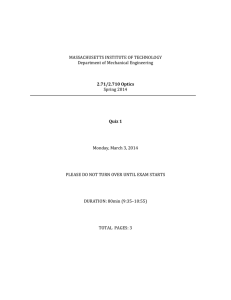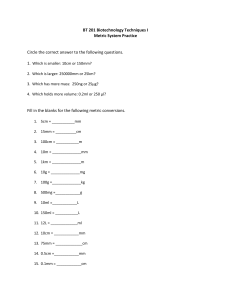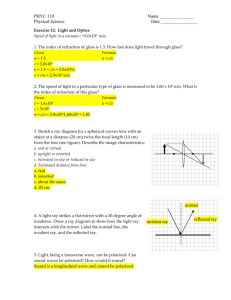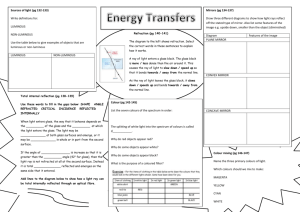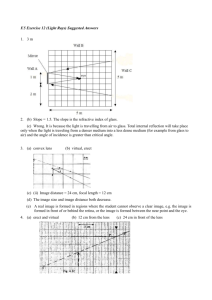2.71/2.710 Optics, Spring 2014, Solution for Quiz 1
advertisement
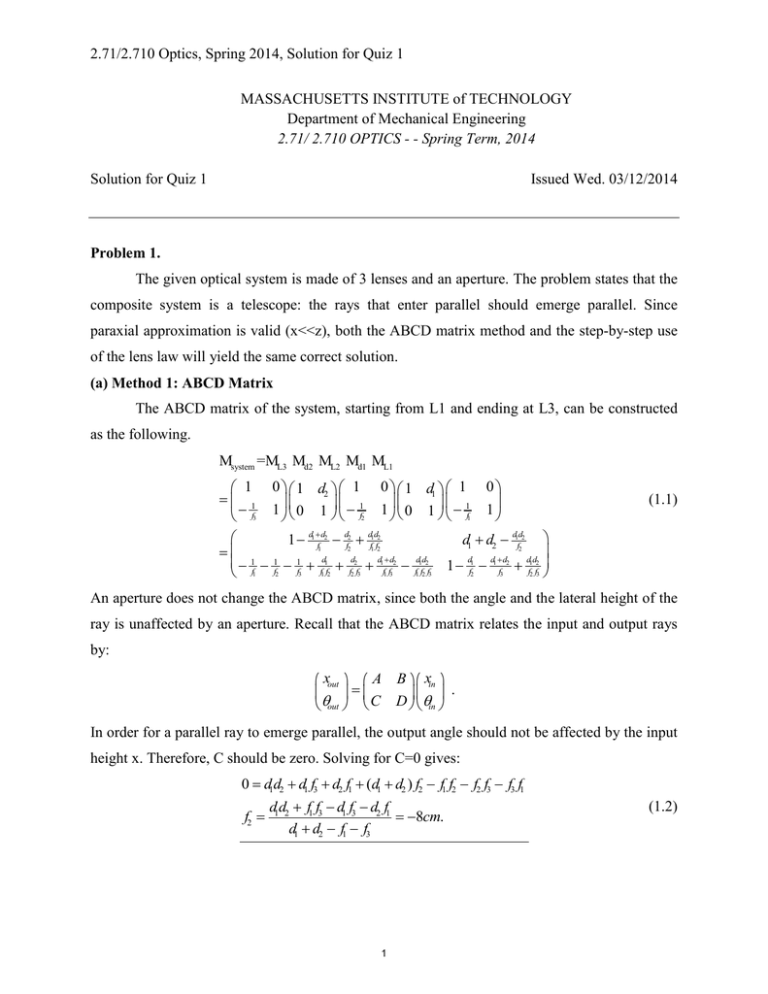
2.71/2.710 Optics, Spring 2014, Solution for Quiz 1 MASSACHUSETTS INSTITUTE of TECHNOLOGY Department of Mechanical Engineering 2.71/ 2.710 OPTICS - - Spring Term, 2014 Solution for Quiz 1 Issued Wed. 03/12/2014 Problem 1. The given optical system is made of 3 lenses and an aperture. The problem states that the composite system is a telescope: the rays that enter parallel should emerge parallel. Since paraxial approximation is valid (x<<z), both the ABCD matrix method and the step-by-step use of the lens law will yield the same correct solution. (a) Method 1: ABCD Matrix The ABCD matrix of the system, starting from L1 and ending at L3, can be constructed as the following. Msystem =ML3 Md2 ML2 Md1 ML1 1 0 1 d2 1 0 1 d1 1 0 1 1 1 f3 1 0 1 f2 1 0 1 f1 1 1 d1 f1d2 df22 df11df22 d1 d2 d1fd22 1f 1f 1f fd1f fd2f d1ffd2 fd1fd2f 1 df1 d1 f d2 df1df2 1 3 1 2 3 2 3 2 3 1 2 3 12 23 (1.1) An aperture does not change the ABCD matrix, since both the angle and the lateral height of the ray is unaffected by an aperture. Recall that the ABCD matrix relates the input and output rays by: xout A B xin . out C D in In order for a parallel ray to emerge parallel, the output angle should not be affected by the input height x. Therefore, C should be zero. Solving for C=0 gives: 0 d1d2 d1 f3 d2 f1 (d1 d2 ) f2 f1 f2 f2 f3 f3 f1 f2 d1d2 f1 f3 d1 f3 d2 f1 8cm. d1 d2 f1 f3 1 (1.2) 2.71/2.710 Optics, Spring 2014, Solution for Quiz 1 Method 2. Step-by-step lens law For light propagating in the positive direction, the object distance so is defined to be positive for an object place on the left side of the lens. The image distance si is defined to be positive for an image appearing on the right side of the lens. A parallel ray can be expressed as an object placed at so1 . Writing out the lens law for L1, we see that 1 1 1 , so1 si1 f1 ( so1 , f1 4cm) si1 f1 4cm . (1.3) After passing through L1, a parallel ray will focus at the focal point, si1 f1 . Next, the image from L1 becomes the object for L2. The object distance can be calculated from so 2 d1 si1 , with respect to L2. Using the lens law for L2, we obtain: 1 1 1 , so 2 si 2 f2 ( so1 2cm) , (1.4) where both f 2 and si 2 are unknown. The image from L2 becomes the object for L3. With respect to L3, the object distance can be calculated from so3 d2 si 2 . Since the problem states that the output beam from a parallel input beam should also be parallel, we know that si 3 . 1 1 1 , so3 si 3 f3 ( si 3 , f3 3cm) so3 f3 3cm . (1.5) Plugging in this result back to (1.4), using so3 d2 si 2 , we obtain si 2 1.6cm and: 1 1 1 2cm 1.6cm f2 f2 8cm. (1.6) Indeed, the same answer with (1.2) is obtained. (b) The angular magnification power of the telescope system is out / in . Using ABCD method, we can calculate: out / in D 1 df1 d1 f d2 df1df2 1.06 . 2 3 2 3 (1.7) Alternatively, step-by-step lens law gives the same answer: si1 si 2 si 3 4 1.6 1.06 . so1 so 2 so3 2 3 The angular magnification power is -1.06. 2 (1.8) 2.71/2.710 Optics, Spring 2014, Solution for Quiz 1 (c) Using the ABCD matrix approach, we can construct the overall matrix including the propagation from the object to L1 as s1 , and the propagation from L3 to the image as s2 . 1 s1 A B 1 s2 A B Mtotal Ms2 Msystem Ms1 0 1 C D 0 1 C D (1.9) In order for the system to form an image, B 0 should be satisfied, which gives: B As1 B Ds2 Cs1s2 0 s2 As1 B 0.9375 4 8.45 4.406 D 1.06 (1.10) Therefore the image forms 4.406cm to the right of L3. Alternatively, the step-by-step lens law yields: 1 1 1 , s1 si1 f1 1 1 1 , si1 4 si1 4 so 2 d1 si1 1 1 1 , so 2 si 2 f 2 1 1 1 , si 2 8 si 2 8 so3 d2 si 2 9.4 1 1 1 , so3 s2 f3 1 1 1 s2 4.406 9.4 s2 3 (1.11) (1.12) (1.13) (1.14) (1.15) We get the same answer with (1.10). (d) The entrance (exit) pupil is the image of the aperture stop through all optical elements before (after) the aperture stop. The EnP is calculated by using the lens law for L1 in the backward direction: 1 s AS L1 1 sEnP 1 , f1 1 1 1 , sEnP 36cm . 4.5 sEnP 4 (1.16) Therefore the EnP is located 36cm to the left of L1. Note that when the object is imaged in the backward direction as in this case, simply substituting a negative value for so doesn’t work. 1 4.5 s1 14 : (incorrect!) . i 3 2.71/2.710 Optics, Spring 2014, Solution for Quiz 1 For the ExP, we can write the consecutive lens law for L2 and L3 in the forward direction: 1 sL2 AS 1 1 , s2 f 2 1 1 1 , d2 s2 sExP f3 1 1 1 , s2 1.2632 1.5 s2 8 1 1 1 , sExP 23.72 2.6632 sExP 3 (1.17) (1.18) Therefore the ExP is located 23.72cm to the left of L3. The object is located at the focal point of L1. Therefore, the marginal ray that leaves the axial point on the object plane becomes parallel to the axis after passing through L1. Therefore, the NA can be calculated by 2 tan 1 D/2 0.25, D 1.005cm . s1 The diameter of the AS is 1.005cm. 4 (1.19) 2.71/2.710 Optics, Spring 2014, Solution for Quiz 1 Problem 2. Silvered Glass Hemisphere A paraxial ray incident on the flat side of the hemisphere goes through the following: (1) Flat glass surface: refraction, change in angle if incident ray is not parallel. (2) Straight propagation inside glass, + direction. (3) Reflection at a curved surface with radius R: change in angle, and direction. (4) Straight propagation inside glass, – direction. (5) Flat glass surface: refraction, change in angle if incident ray is not parallel. Recall that a paraxial approximation is necessary to define a single focus for a non-parabolic surface. Under the paraxial approximation, sin tan . (a) Graphically, steps (1) through (4) for a parallel incident ray are depicted in Figure 1. Figure 1 The focal point of a curved reflector can be obtained from the intersection between the reflection of the parallel ray and the horizontal axis. From the equality of the three angles marked in Figure 1, we see that the length fO and fP are equal. Therefore, the focal point is the midpoint between O and R. Since the mirror is concave, R 7.5cm , and f R / 2 3.75cm . The focal length of a concave mirror is positive. 5 2.71/2.710 Optics, Spring 2014, Solution for Quiz 1 b) We are now given a bubble that is inside the glass hemisphere. There are two images: (1) Object refracted through plane, (2) Object reflected by hemispherical mirror, then refracted through plane. (1) Object refracted through plane The first image can be obtained by tracing a ray that leaves the object parallel towards the left, and another ray that hits the axial point of the glass surface. The image is erect, and has the same height as the object, as shown in Figure 2. This is a virtual image since the outgoing rays from a point on the object always diverge, rather than converge to form a real image. Figure 2 The location of the image can be obtained from the snell’s law between the two angles g , a : na sin a ng sin g , na a ng g . (1.20) In the paraxial limit, the two equations of (1.20) are equal. The location of the image with respect to the center of the hemisphere O can be obtained by comparing the two triangles, with angles g ,a at O. The location of the image can be found from: si tan a so tan g , si so g / a so na / ng 5cm /1.5 3.3cm. Thus, the upright, virtual image is located 3.33cm to the right of the flat glass surface. 6 (1.21) 2.71/2.710 Optics, Spring 2014, Solution for Quiz 1 (2) Object reflected by hemispherical mirror, then refracted through plane. The second image can be obtained by tracing a ray leaving the object parallel to the axis towards the mirror, which is reflected to pass through the focal point. Next, a ray that hits the axial point of the mirror can be traced. The left side of Figure 3 shows the virtual image formed from reflection, in green dotted lines. Figure 3 This virtual image is erect and is larger than the object. The location of the image can be obtained from: 1 1 1 1 , so si f R / 2 1 1 1 si 7.5cm . 7.5cm 5cm si 3.75cm (1.22) Therefore, the virtual image is located 7.5cm to the right of the vertex of the hemisphere, before refraction by the flat glass surface. Since the observer is in the air, the green rays are once more refracted by the flat glass surface. The red rays in the right side of Figure 3 depict this refraction. The solid red rays represent the corrected image that the observer in the air can see. The location of the refracted image can be obtained in the same way from (1.21): si tan a so tan g , si so g / a so na / ng 15cm /1.5 10cm. Therefore, the virtual image is located 10cm to the right of the flat glass surface. 7 (1.23) 2.71/2.710 Optics, Spring 2014, Solution for Quiz 1 c) Let us consider the path of light to calculate the effective focal length for the system. Light is incident from the left side of the flat surface, and goes through the following components: (1) Refraction. Air into glass (2) Propagation. d=7.5cm (3) Concave Mirror Reflection. f=-2/R=3.75cm (4) Propagation. d=7.5cm (5) Refraction. Glass into air There is no way that light can reach inside the system without being refracted at the flat surface. Therefore the system is defined to start and finish right outside the flat glass surface in air, rather than inside the glass. The system ABCD matrix can be calculated as: Msystem =M(5) M(4) M(3) M(2) M(1) 1 0 1 d 1 01 d 1 0 0 nng 0 1 1f 1 0 1 0 nna g a 1 d 1 01 d 0 nng R2 1 0 nna g a 2 n 1 2Rd 2 Rd d (1 na ) g 1 0 , n n a 2 1 nga 2Rd 0.4 1 ng R (1.24) where R 7.5cm, d 7.5cm, na 1, ng 1.5 . From (1.24), we calculate the EFL to be: EFL 1 2.5cm. C (1.25) d) The principle planes are displaced from FFP and BFP by EFL: PP1+EFL=FFL, PP2+EFL=BFL. Since both FFP and BFP are located 2.5cm to the right of the flat glass surface, Both PP’s are located 5cm to the right of the flat glass surface. Alternatively, using the ABCD matrix, we can get: PP1 ( D 1) C 5cm, PP2 (1 A) C 5cm. (1.26) Indeed, the 1st PP is located 5cm to the right of the input plane, which is the flat surface. The 2nd PP is also located 5cm to the right with respect to the output plane, which is again the flat surface. (The negative sign of PP2 results from the negative propagation direction: -5cm to the left is the same as 5cm to the right.) The principle planes overlap at 5cm to the right of the flat surface. 8 MIT OpenCourseWare http://ocw.mit.edu 2.71 / 2.710 Optics Spring 2014 For information about citing these materials or our Terms of Use, visit: http://ocw.mit.edu/terms.
